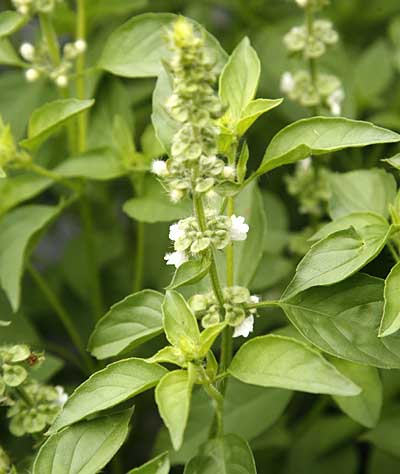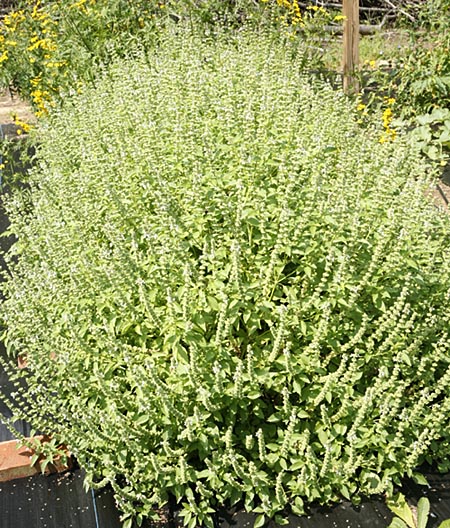For those who love basil this one has a zesty difference. The leaves and stems smell and taste like lime. The aroma and flavor are quite strong. It is a lovely plant which does not seem to suffer from pests in the way that ordinary basil sometimes does. It makes a great ornamental as well as a culinary herb. Ideal for the herb garden, in a border or even a patio pot. Deer don't eat it, neither do rabbits but butterflies and beneficial insects love the flowers.
Description of Lime Basil (Ocimim Americanum).
Lime basil has bright lighter green leaves that are ovoid with gently scalloped
margins and deep veins. They are arranged opposite on square stems. The flowers
arise at the tops of the branches in large spikes of small white flowers from
July onwards. Plants can grow up to three feet in height and about 18"
wide. Flower spikes can reach higher under the right conditions.
Growing Lime Basil (Ocimim Americanum) from Seed.
All basils are very easy to grow from seed. Follow our general
growing instructions. Lime basil seeds are slightly different from other
basils in that they produce a gelatinous outer coating which appears when the
seeds are wet. For this reason it is essential that the seeds be kept moist
but not wet as the coating is susceptible to molds. Keep compost slightly dry
at all times but do not let it dry out entirely. Pot on when seedlings are large
enough to handle and plant out after hardening off.
Lime Basil can easily be grown indoors in pots all year around to ensure fresh
herb for the kitchen. Starting seeds in early spring ready for outdoor planting
will help increase the season length. Seeds can then either be sown throughout
the year in pots if desired or sown directly in the ground once all danger of
frost has passed.
Germination usually takes about 14-20 days depending on temperature.
Location and Care of Lime Basil (Ocimim Americanum).
Lime Basil is easy to grow from seed but takes a little more care than some
other herbs. It likes full sun, but in very warm sunny areas partial shade is
advisable. It prefers a soil with good organic material for the best lush growth
of leaves.
It also likes a pretty rich soil and grows best with a good mulching. The more organic material and fertilizer it gets the richer the leaf growth is. Lush leaves are usually what is required on a Lime basil plant unless its grown as an ornamental. For leaf harvest lots of fertilizer and nitrogen will increase leaf growth and reduce it the likelihood of flowering. If cared for it will produce a multitude of leaves that can be constantly picked for use in the kitchen.
Flowers should be pinched off as soon as they begin to appear if the plant is begin grown for leaves. No basil produces a good crop of leaves after it begins to flower so this must be discouraged. Flowering signals the end of the lifespan so the longer it can be kept from flowering the longer the plant will live. However it is an annual and will rarely live longer than six months in the ground and as little as 3-4 in a pot.
Lime Basil needs more water than many other herbs. Lime Basil is a lush plant and will not tolerate any drought. Daily watering is essential for good productive plants. In times of drought and high heat water more frequently.
When watering try to get all the water at the soil level and not on the leaves. Water droplets on the leaves can act as little lenses and burn the leaves. Avoid splashing the water and soil up on the leaves as this can promote fungal molds. An ideal way to water basil in the ground is by using a soaker hose. This allows water to reach the roots without getting any on the leaves and its easier for the gardener so all you need to do is turn on the hose once a day. Or you can get a timer and let it be watered automatically.
Lime Basil is a tender plant and will not tolerate frost. As soon as the weather turns cold the leaves begin to turn black. In areas where there is not frost the plants can live for two or more years. Basils can tolerate slightly acidic soils. If the pH is lower than 6.5, add a dressing of lime when preparing the soil.
Lime Basil is a great addition to any flower bed as the bright green leaves and exotic look of the plant add interest and can be a very nice backdrop for other flowering plants. To keep basil at it's best for leaf production pinch off the flower stalks as they arise. This may be an ongoing process if the plant is happy as it will want to flower. However flowering will reduce leaf production and pinching encourages the plant to branch and produce even more leaves.
Plant spacing and airflow.
Allow plenty of air space around your basil plants. IF growing a row keep plants
at least 2 feet apart. If growing in a border keep other plants back slightly
to allow for airflow. Don't grow Basil in areas where there is little airflow.
Basil can be highly susceptible to fungal molds and allowing good airflow around
the plant can greatly reduce the likelihood of this happening to your plants.
Keep chemicals away from your basil.
Don't grow any Basil in a area where it could be sprayed by chemicals, if you
use chemicals on your lawn ensure that your basil plants are not right next
to it. Try not to grow it near your property boundary where chemicals used by
your neighbor may land on your plants. Always wash the leaves well before eating.
Great of decks, boxes and hanging baskets.
Lime Basil is a very versatile plant and can be grown in hanging baskets, pots
and even on the windowsill offering fresh basil throughout the winter months.
If leaves are harvested regularly the plants can be kept small. This plant is
rich in several important nutrients, most notably vitamin A, vitamin C. It also
contains high concentrations of Carotenoids like beta carotene, and these substances
are converted to vitamin A within the body. It may be a good source of iron,
potassium, and magnesium depending on what it can extract from your soil.
What's this yucky stuff on my lime basil plant?
If you allow your lime basil plants to flower, and produce seed don't be alarmed
if you see the plant covered in what looks like insect eggs or 'frog spawn'
after rain. This is just the gelatinous coating on the seeds that have dropped
out when the rains came. Nothing has attacked your plant or laid eggs on it,
and its still perfectly fine to eat.
Harvesting of Lime Basil (Ocimim Americanum).
Once your basil plants are growing well pinch off the central stem when they
are about twelve inches high. After this prune back each stem when it has more
then 8 leaves on it. Harvest the young fresh leaves as needed, the plant grows
back quickly as the more it is harvested and pinched the more likely it will
be to branch and produce more leaves. Always harvest the leaves from the tops
of the stems taking about one third of the stem only. Pinch or cut with snips
or scissors when harvesting, don't tear the leaves off as this can cause wounds
allowing infection to enter the plant. Also don't just pull off one large leaf
or you will get no new growth and the plant can become stunted. Continuous harvesting
of new leaves allows more growth for recutting. If done effectively each plant
should yield about half a cup of leaves every week throughout the season. (expect
less on plants grown on indoors in windows).
Leaves can be frozen in air tight bags for later use, if drying pick whole stems, tie together and hang up to dry. Leaves can also be packed in jars in olive oil or used to flavor vinegar's for winter use. Make sure you harvest all your leaves before the first frost is due.
Edible Uses of Lime Basil (Ocimim Americanum).
Lime basil can be used just like regular basil but with the sharp lime flavor
it can be a great addition to fish, salads and even deserts. Try adding it to
your drink in the summer months. This very versatile herb is a must for the
gardener who loves herbs.








